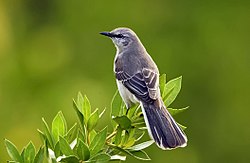Mockingbird: Difference between revisions
Content deleted Content added
Grammar. |
No edit summary |
||
| Line 18: | Line 18: | ||
}} |
}} |
||
'''Mockingbirds''' are a group of [[New World]] [[passerine]] [[bird]]s from the [[Mimid]]ae [[family (biology)|family]]. They are best known for the habit of some species mimicking the songs of other birds, often loudly and in rapid succession. Mockingbirds also have a reputation of being fierce defenders of |
'''Mockingbirds''' are a group of [[New World]] [[passerine]] [[bird]]s from the [[Mimid]]ae [[family (biology)|family]]. They are best known for the habit of some species mimicking the songs of other birds, often loudly and in rapid succession. Mockingbirds also have a reputation of being fierce defenders of asdfouiasdoupiasduopisadfopuifdsao;jifdsa17 [[species]] in three [[genus|genera]]. These do not appear to form a [[monophyletic]] lineage: ''[[Mimus]]'' and ''[[Nesomimus]]'' are quite closely related; their closest living relatives appear to be some [[thrasher]]s, such as the [[Sage Thrasher]]. ''[[Melanotis]]'' is more distinct; it seems to represent a very ancient [[Basal (phylogenetics)|basal]] lineage of Mimidae.(Hunt ''et al.'' 2001, Barber ''et al.'' 2004) |
||
Most species are [[tropical]], but the [[Northern Mockingbird]] breeds throughout the [[United States]] and [[Canada]], including the northern [[Caribbean]] area. There are about 17 [[species]] in three [[genus|genera]]. These do not appear to form a [[monophyletic]] lineage: ''[[Mimus]]'' and ''[[Nesomimus]]'' are quite closely related; their closest living relatives appear to be some [[thrasher]]s, such as the [[Sage Thrasher]]. ''[[Melanotis]]'' is more distinct; it seems to represent a very ancient [[Basal (phylogenetics)|basal]] lineage of Mimidae.(Hunt ''et al.'' 2001, Barber ''et al.'' 2004) |
|||
Mockingbirds represent the destruction of innocence in a novel by award-winner Harper Lee. |
Mockingbirds represent the destruction of innocence in a novel by award-winner Harper Lee. |
||
Revision as of 01:36, 13 February 2008
| Mockingbird | |
|---|---|

| |
| Northern Mockingbird Mimus polyglottos | |
| Scientific classification | |
| Kingdom: | |
| Phylum: | |
| Class: | |
| Order: | |
| Family: | |
| Genera | |
Mockingbirds are a group of New World passerine birds from the Mimidae family. They are best known for the habit of some species mimicking the songs of other birds, often loudly and in rapid succession. Mockingbirds also have a reputation of being fierce defenders of asdfouiasdoupiasduopisadfopuifdsao;jifdsa17 species in three genera. These do not appear to form a monophyletic lineage: Mimus and Nesomimus are quite closely related; their closest living relatives appear to be some thrashers, such as the Sage Thrasher. Melanotis is more distinct; it seems to represent a very ancient basal lineage of Mimidae.(Hunt et al. 2001, Barber et al. 2004)
Mockingbirds represent the destruction of innocence in a novel by award-winner Harper Lee.

References
- Barber, Brian R.; Martínez-Gómez, Juan E. & Peterson, A. Townsend (2004): Systematic position of the Socorro mockingbird Mimodes graysoni. J. Avian Biol. 35: 195-198. doi:10.1111/j.0908-8857.2004.03233.x (HTML abstract)
- Hunt, Jeffrey S.; Bermingham, Eldredge; & Ricklefs, Robert E. (2001): Molecular systematics and biogeography of Antillean thrashers, tremblers, and mockingbirds (Aves: Mimidae). Auk 118(1): 35–55. DOI:10.1642/0004-8038(2001)118[0035:MSABOA]2.0.CO;2 HTML fulltext without images
- )
